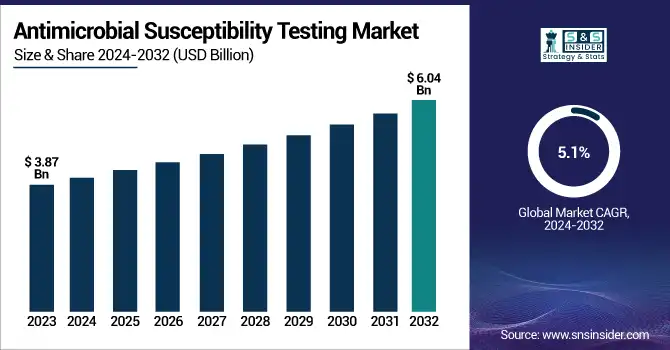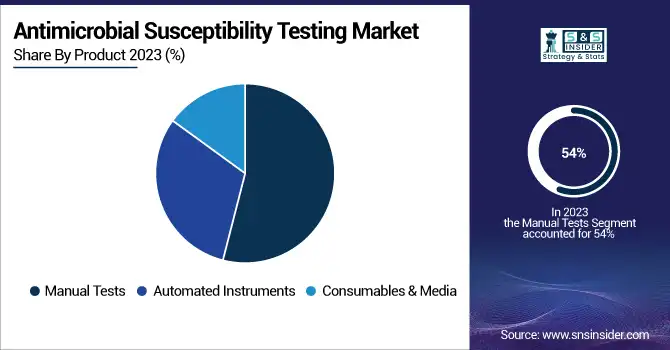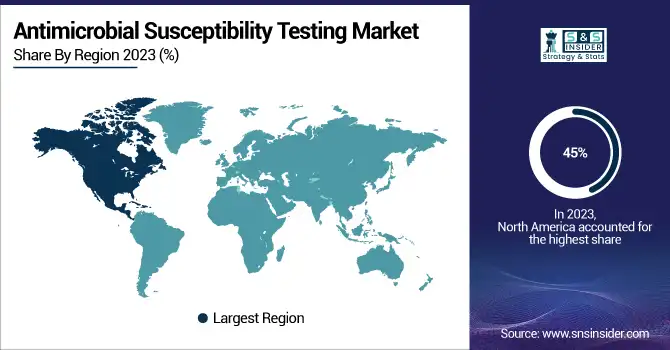Antimicrobial Susceptibility Testing Market Size Analysis:
The Antimicrobial Susceptibility Testing Market Size was valued at USD 3.87 Billion in 2023 and is expected to reach USD 6.04 Billion by 2032, growing at a CAGR of 5.1% over the forecast period 2024-2032.
The Antimicrobial Susceptibility Testing (AST) Market report gives insights such as the growth of AMR (antimicrobial resistance) incidence and prevalence, driving the demand for AST solutions. The report reviews the adoption of technologies, automated, AI-driven, and rapid molecular methods relative to conventional methods. It also provides region-wise regulatory compliance FDA, CE Mark approvals, and global quality standards. Healthcare spending on AST is analyzed across government, private, and out-of-pocket expenditures. The rising global burden of antimicrobial resistance (AMR) that affects more than 2.8 billion infections every year in the U.S. itself causing more than 35,000 deaths is a major driving factor for the Antimicrobial Susceptibility Testing (AST) market.

To get more information on Antimicrobial Susceptibility Testing Market - Request Sample Report
Antimicrobial Susceptibility Testing Market Dynamics
Drivers
-
The increasing prevalence of AMR necessitates precise diagnostics to guide effective treatments.
Rising incidents of antimicrobial resistance (AMR) are one of the major factors propelling the growth of the Antimicrobial Susceptibility Testing (AST) market. This problem is underscored by recent data. A recent study estimates that without effective intervention in the coming years, AMR will cause more than 39 million deaths per year by 2050, including an estimated 169 million deaths due to drug-resistant infections projected for that year. India is amongst the worst affected in this regard. Resistance against the antibiotic imipenem, a type of carbapenem, was alarmingly high in one 2023 ICMR study among patients with bloodstream infections caused by two main pathogens Klebsiella pneumoniae and Acinetobacter baumannii in the ICU. Moreover, pathogens including Staphylococcus aureus and Enterococcus faecium were resistant to oxacillin and vancomycin, respectively.
The inappropriate use of antibiotics in different sectors contributes to AMR on a global scale. In another study, 71% of research laboratories performing animal research regularly used antimicrobial drugs without regulations in Australia and New Zealand to develop drug-resistant bacteria. World leaders have pledged to reduce the number of deaths attributed to superbugs by 10% by 2030, reflecting the rising threat of AMR. This political declaration, which has the support of 193 member states across the UN system, demands increased action across many areas, including agriculture, medicine, the environment, and health.
Restraint:
-
Advanced AST systems are expensive, limiting adoption, especially in resource-limited settings.
The high cost of automated instruments is a significant restraint in the Antimicrobial Susceptibility Testing (AST) market. Advanced automated AST systems, while offering rapid and accurate results, require substantial investments in research, development, and manufacturing. These sophisticated technologies require constant maintenance and simple recalibrating, which adds up to cost. For example, mass-spectrometry-based antimicrobial susceptibility testing (AST) costs around USD 83.3 per patient based on the cost of the device, reagents, and time of relevant personnel.
These exorbitant prices are a considerable burden, especially for smaller health care institutions and those with few resources, and it restricts the uptake of such high-tech solutions. This economic limitation suggests the need for automated AST systems with the potential to be implemented on a large-scale, yet, the uptake of such systems is likely to be delayed, consequently losing out on economised-based antimicrobial resistance diagnosis. However, the major obstacle regarding the development of automated instruments is the cost of these machines, which improves the efficiency and accuracy of AST.
Opportunity:
-
Development of rapid and automated AST platforms offers quicker and more accurate diagnostics, enhancing patient care.
Rapid Antimicrobial Susceptibility Testing (AST) advancements are promising outcome changes to patient-oriented diagnostics. Conventional approaches take more than 48 hours to determine appropriate antibiotics; however, several advances have been introduced that can cut the time frame of identification. An example is that researchers Professor Kwon Sung-hoon of Seoul National University and QuantaMatrix's team have developed a new method that shortens the time required for the diagnosis and treatment of sepsis infections to about 12 hours by omitting the time-consuming culture step. In this method, special peptide molecules are used to attach to magnetic nanoparticles to trap lethal pathogens in a blood sample that can then be analyzed and exposed to different antibiotics. An AI system predicts the most effective treatments. This approach could be implemented in clinics within two to three years and may also help curb the rise of antibiotic-resistant bacteria by reducing the use of broad-spectrum antibiotics.
Another revolutionary aspect is the use of nanomotion technology aided by machine learning. HKU scientists developed a method to provide a rapid assessment of antimicrobial susceptibility based on the measurement of bacterial vibrations, which will take only a small fraction of time compared to existing culture-based methods using agar media. The system predicted susceptibility and resistance in 1,180 spiked positive blood culture samples, with accuracies ranging from 89.5% to 98.9%. Localization of AST with respect to blood cultures has also been attempted recently where FASTinov has developed an ultra-rapid AST providing phenotypic antimicrobial susceptibility results within 2 hrs from blood cultures. This approach relies on flow-cytometric demonstration of initial cell lesions or metabolic changes and provides a rapid and accurate diagnosis.
Challenge:
-
Stringent and varied regulatory requirements across regions complicate the development and approval of new AST products.
The Antimicrobial Susceptibility Testing (AST) market faces major hurdles as the regulatory framework in multiple countries is evolving and complex. These frameworks typically need long validation pipelines for the reliability and accuracy of AST kits. For example, in Jan 2025 new protocols were issued by Indian Council for Medical Research (ICMR) stating that validation of antibiotic susceptibility test kits will have to be performed at a minimum of 2 different sites in the country with specific types of specimens used. This type of strict and regional regulation may add a layer of complexity to the development and/or approval of novel AST products. The differing requirements create a higher cost and a longer time to market for new products. Also, stringent standards to comply with sometimes block innovation and advanced AST solutions, in specific regions.
Antimicrobial Susceptibility Testing Market Segmentation Analysis
By Product
The manual tests segment accounted for the largest share of 54% in 2023, owing to their cost-effectiveness, ease of use, and availability in limited resource settings. These tests contain identified disk diffusion methods, minimum inhibitory concentration (MIC) strips, and susceptibility plates. Such manual methods are particularly important in the developing regions that are in Asia-Pacific and parts of Africa wherein such automated systems for livestock are less available due to the expensive nature of these systems. As an example, the WHO demonstrates that manual AST products can help prevent AMR in settings where resources are limited by providing affordable and accurate diagnostic solutions.
The global rise in infectious diseases such as Shigella, Neisseria gonorrhoeae, and Neisseria meningitidis has further fueled demand for manual tests. In addition, initiatives that focus on expanding healthcare infrastructure are also fueling government support in manual testing. For instance, India’s National Programme on AMR Containment encourages the manual AST techniques to strengthen the diagnostics in rural tertiary care centres. Also, these manual methods give the flexibility and cost savings, which is why they are indispensable in small-scale laboratories and hospitals.

By Application
In 2023, the susceptibility testing segment held the largest revenue share which was 47%. The rise in importance of overcoming AMR (Antimicrobial Resistance) requires the determination of effective antibiotics in accordance with the type of infection. According to the CDC, drug resistance is a major driver of increases in bloodstream infections caused by such pathogens, highlighting an ongoing need for reliable AST methods. There has been an increase in funding of AST programs by Governments, and the U.S. National Action Plan for Combating Antibiotic-Resistant Bacteria has placed particular emphasis on the importance of infection prevention and antibiotic stewardship. This is mainly due to the rising incidence of bacterial and fungal infections around the world, which has subsequently increased the need for susceptibility testing to provide appropriate therapeutic management.
By Technique
In 2023, the market was dominated by the disk diffusion method, which accounted for 40% of the market share due to its simple and economic nature and reliability. This approach gives categorical results which are easy to interpret for clinicians and it is really common. This does not need special equipment, making it suitable for low-resource settings where infection control demands rapid results. According to the CDC, disk diffusion remains an essential technique for the detection of resistance in HAIs. A surprisingly common way to detect resistance, the method is most useful for finding the hard-to-catch type of resistance common to pathogens E. coli and K. pneumoniae, which are two of the most common pathogens found in bloodstream infections and pneumonia. Despite its limitations, disk diffusion can increase its practicality further by enabling laboratories to create local antibiotic disks according to local trends regarding resistance.
Due to the increasing burden of AMR, globally important health organizations, including the American Society for Microbiology (ASM) and the European Committee on Antimicrobial Susceptibility Testing (EUCAST), have advocated for the continued role of disk diffusion in conjunction with automated systems. This is a very low-cost technique to implement and will always be a mainstay in AST.
By End-Use
Based on end use, the market was dominated by hospitals with a 39% share in 2023, as hospitals are primary facilities for AST implementation. Rising incidences of HAIs due to resistant pathogens, as well as the demand for AST solutions to improve patient outcomes, have accelerated market growth. Multidrug-resistant organisms remain in the top ten existing pathogens causing healthcare-associated infections (HAIs) and have sharply increased since the pandemic, as outlined by the CDC, highlighting the need for strong diagnostics.
Governments worldwide are making it a high-priority issue to fund hospital-based AMR containment programs. For instance, India’s National Programme on AMR Containment emphasizes providing advanced diagnostic tools in hospitals and establishing training facilities for the healthcare workforce regarding AST methods. Similarly, North American hospitals gain from multidimensional funding initiatives, such as the United States's National Action Plan for Combating Antibiotic-Resistant Bacteria.
Regional Insights
In 2024 the antimicrobial susceptibility testing market was dominated by North America, which held 45% of the global share. This leadership is due to strong healthcare infrastructure, substantial investment in R&D, and strong government action against antimicrobial resistance (AMR). According to the U.S. CDC, AMR kills 35,000+ people and infects 2.8 million each year. Automated AST systems and AI-based diagnostic tools have had a solid adoption in the region. Moreover, strong regulatory frameworks and funding programs such as the National Action Plan for Combating Antibiotic-Resistant Bacteria are other factors promoting market growth.
In contrast, Asia-Pacific is expected to witness the fastest CAGR of during the forecast period. The increase is due to the growing consumption of antibiotics, the high prevalence of bloodstream infections, and surging cases of HIV/AIDS. Countries such as India and China are devising national or near-national policies to counter AMR by increasing access to healthcare and diagnostic technologies. India has shown a substantial increase in AST uptake due to their National Programme on AMR Containment for instance. Indispensable Population Base and Increasing Healthcare Expenditure an Impetus for Its Expeditious Growth in The Region.

Need any customization research on Antimicrobial Susceptibility Testing Market - Enquiry Now
Antimicrobial Susceptibility Testing Market Key Players
Key Service Providers/Manufacturers
-
bioMérieux SA: [VITEK 2, VITEK MS]
-
Becton, Dickinson and Company: [BD Phoenix, BD BBL Sensi-Disc]
-
Thermo Fisher Scientific Inc.: [Sensititre AST System, Oxoid Antimicrobial Susceptibility Testing Discs]
-
Danaher Corporation: [MicroScan WalkAway System, DxM MicroScan WalkAway System]
-
Bio-Rad Laboratories, Inc.: [Microbial Identification System, RAPIDEC Carba NP]
-
Bruker Corporation: [MALDI Biotyper, MALDI Sepsityper]
-
Roche Diagnostics: [cobas BACT/ALERT, cobas 4800 System]
-
Accelerate Diagnostics, Inc.: [PhenoTest BC Kit, Pheno System]
-
HiMedia Laboratories: [HiDisc AST Discs, HiCrome Agar Media]
-
Liofilchem s.r.l.: [MIC Test Strips, Chromatic Media]
Key Users:
-
Mayo Clinic
-
Cleveland Clinic
-
Johns Hopkins Hospital
-
Charité – Universitätsmedizin Berlin
-
Singapore General Hospital
-
All India Institute of Medical Sciences (AIIMS)
-
National Health Service (NHS) Hospitals
-
Mount Sinai Hospital
-
Royal Prince Alfred Hospital
-
Groote Schuur Hospital
Recent Developments in the Antimicrobial Susceptibility Testing Market
-
In Jan 2025 the WHO initiated a Project through EVIPNet RADAAR to support Implementing Owner country evidence-based national action plans against AMR in Ghana, Kenya and other parts of the world.
-
In December 2024, Sysmex launched a point-of-care testing system in Europe capable of identifying antimicrobial susceptibility from urine samples in just 30 minutes, accelerating UTI diagnosis.
| Report Attributes | Details |
|---|---|
| Market Size in 2023 | USD 3.87 Billion |
| Market Size by 2032 | USD 6.4 Billion |
| CAGR | CAGR of 5.1% From 2024 to 2032 |
| Base Year | 2023 |
| Forecast Period | 2024-2032 |
| Historical Data | 2020-2022 |
| Report Scope & Coverage | Market Size, Segments Analysis, Competitive Landscape, Regional Analysis, DROC & SWOT Analysis, Forecast Outlook |
| Key Segments | • By Product (Manual Tests, Automated Instruments, Consumables & Media) • By Application (Drug Development, Susceptibility Testing, Others) • By Technique (Automated AST, Etest Method, Dilution, Disk Diffusion, Others) • By End-use (Hospitals, Diagnostic Laboratories, Antimicrobial Susceptibility Testing, Others) |
| Regional Analysis/Coverage | North America (US, Canada, Mexico), Europe (Eastern Europe [Poland, Romania, Hungary, Turkey, Rest of Eastern Europe] Western Europe] Germany, France, UK, Italy, Spain, Netherlands, Switzerland, Austria, Rest of Western Europe]), Asia Pacific (China, India, Japan, South Korea, Vietnam, Singapore, Australia, Rest of Asia Pacific), Middle East & Africa (Middle East [UAE, Egypt, Saudi Arabia, Qatar, Rest of Middle East], Africa [Nigeria, South Africa, Rest of Africa], Latin America (Brazil, Argentina, Colombia, Rest of Latin America) |
| Company Profiles | bioMérieux SA, Becton, Dickinson and Company, Thermo Fisher Scientific Inc., Danaher Corporation, Bio-Rad Laboratories, Bruker Corporation, Roche Diagnostics, Accelerate Diagnostics, Inc., HiMedia Laboratories, Liofilchem s.r.l. |

